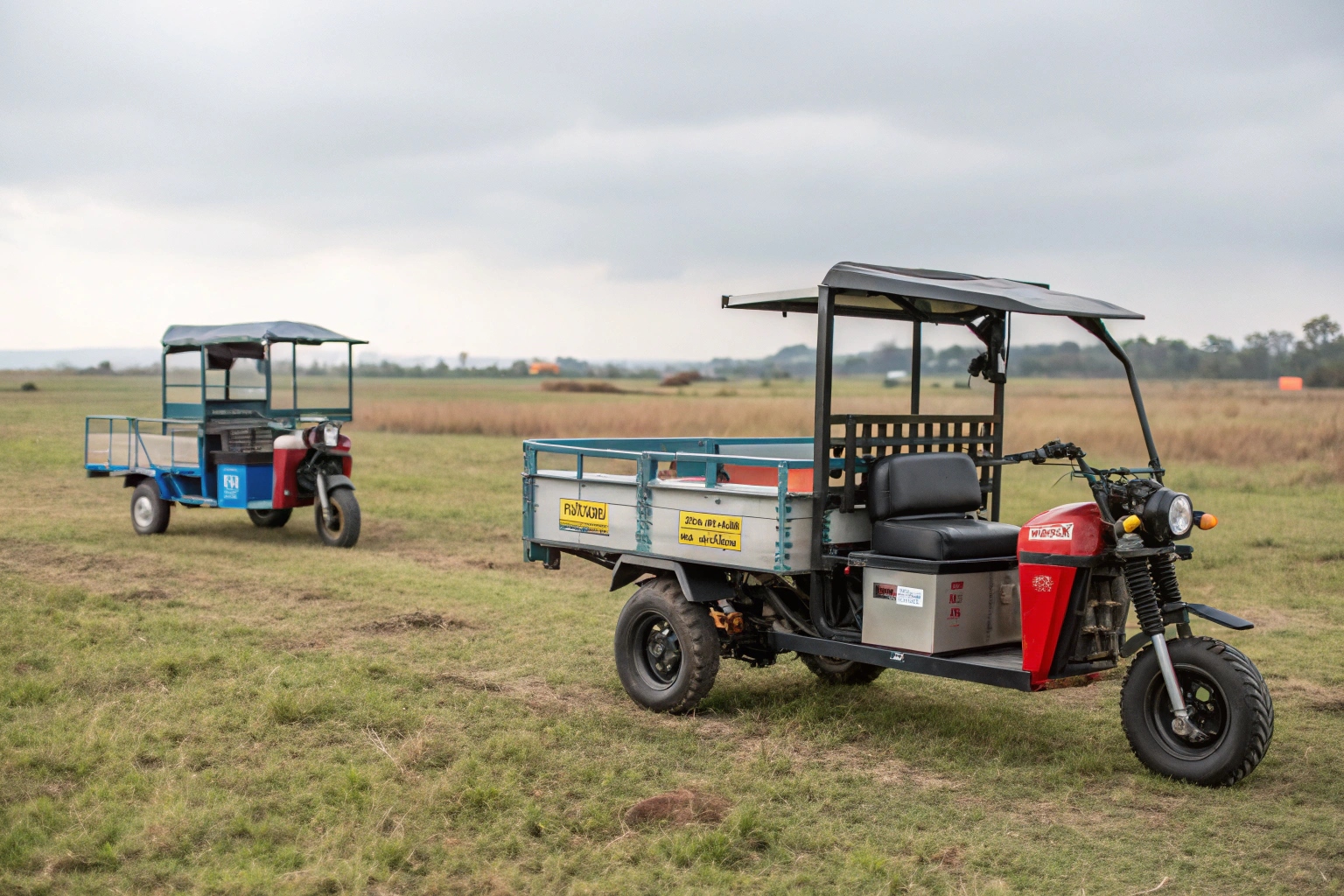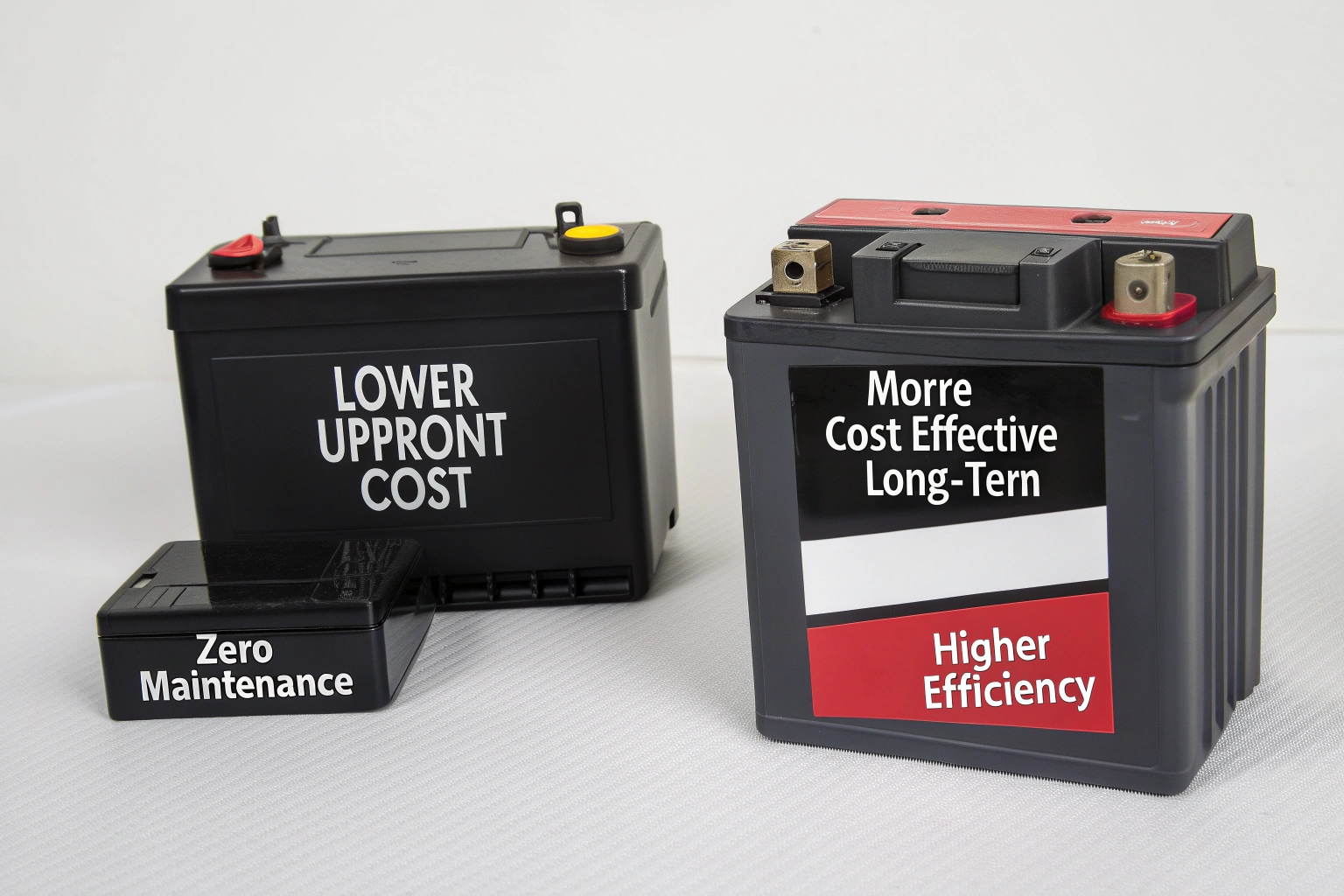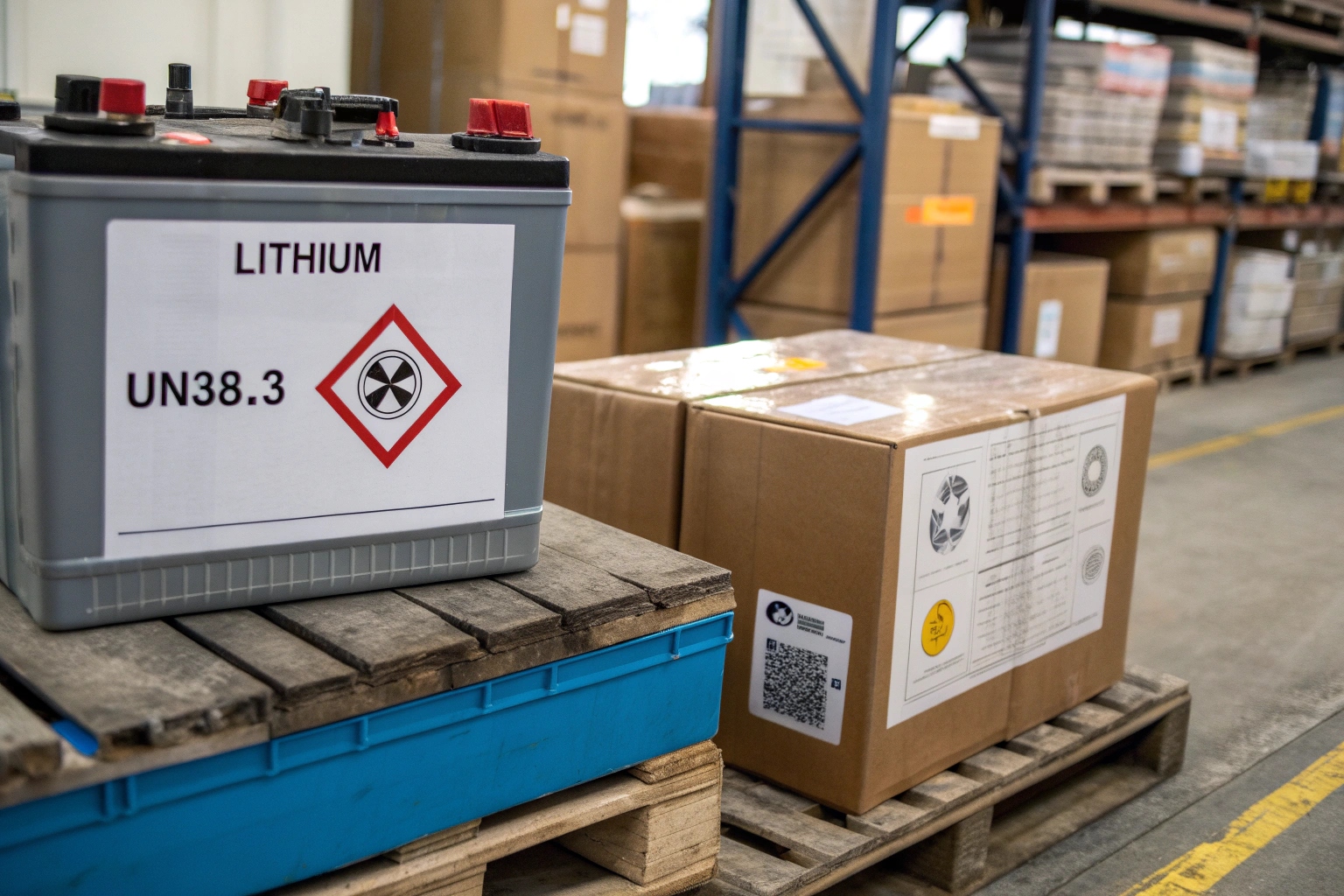Vous avez du mal à choisir la bonne batterie pour votre flotte de tricycles électriques ? Faire un mauvais choix peut réduire vos bénéfices et nuire à votre réputation. Trouvons la meilleure solution pour votre entreprise.
Pour la plupart des importateurs, le choix dépend de la sensibilité au prix de votre marché et de l'utilisation prévue du véhicule. Le plomb-acide est idéal pour les applications légères et peu coûteuses, tandis que le lithium offre une meilleure valeur et de meilleures performances à long terme pour les cas d'utilisation intensive ou à haute fréquence, justifiant son prix initial plus élevé.

En tant qu'usine qui expédie des tricycles électriques dans le monde entier, c'est l'une des questions les plus fréquentes que je reçois de la part des importateurs. La réponse n’est jamais simple : « celui-ci est meilleur ». La meilleure batterie est celle qui aide votre client à faire son travail efficacement et vous aide à bâtir une entreprise rentable. UN batterie haut de gamme dans un marché qui ne peut pas se le permettre, il restera simplement dans votre entrepôt. D'un autre côté, un batterie sous-alimentée dans une application exigeante conduira à des clients mécontents. Alors, décomposons les vrais facteurs que vous devez prendre en compte.
Quelles sont les principales différences entre les batteries au plomb et au lithium ?
Vous êtes confus par les spécifications techniques telles que la densité énergétique et la durée de vie ? Ces détails ont un impact direct sur les performances et le poids de votre véhicule. Clarifions ce qu'ils signifient pour votre entreprise.
Les principales différences résident dans le poids, la taille, la durée de vie et l’entretien. Les batteries au lithium sont beaucoup plus légères et plus petites pour la même puissance, durent beaucoup plus longtemps et ne nécessitent aucun entretien. Les batteries au plomb sont plus lourdes, plus volumineuses, ont une durée de vie plus courte et nécessitent des contrôles réguliers.

Lorsque nous construisons des tricycles en usine, le choix de la batterie change toute la dynamique du véhicule. Ce n'est pas seulement une source d'énergie ; c'est un composant essentiel qui affecte tout, de la charge utile à la manipulation. Pour vous aider à comprendre, je vais détailler les points techniques les plus importants d'un point de vue pratique et axé sur l'entreprise.
Densité énergétique et poids
La densité énergétique signifie simplement la quantité d’énergie qu’une batterie peut stocker pour sa taille et son poids. Le lithium est clairement le gagnant ici. Une batterie au lithium peut peser jusqu’à la moitié du poids d’une batterie au plomb de même capacité. Pour un tricycle cargo électrique, c’est une affaire énorme. Une batterie plus légère signifie que le véhicule lui-même est plus léger, ce qui se traduit directement par le transport de plus de marchandises. J'avais un client en Colombie qui gère un service de livraison du dernier kilomètre. En faisant passer sa flotte au lithium, il pourrait augmenter la charge utile de chaque tricycle de près de 60 kg. Cela représente 60 kg de colis supplémentaires à chaque voyage, ce qui a directement amélioré l'efficacité et la rentabilité de sa flotte.
Durée de vie et durabilité (cycle de vie)
A "cycle" est une charge et une décharge complètes. La durée de vie d’une batterie se mesure en nombre de cycles qu’elle peut gérer avant de commencer à perdre sa capacité à conserver une charge. C’est là que vous voyez la différence la plus spectaculaire.
| Type de batterie | Durée de vie typique (à 80 % de profondeur de décharge) | Durée de vie prévue (utilisation typique) |
|---|---|---|
| Plomb-acide | 300 à 700 cycles | 1 à 3 ans |
| Lithium (LiFePO4) | 2 000 à 5 000+ cycles | 7 à 10 ans et plus |
Comme vous pouvez le constater, une batterie au lithium peut durer plusieurs fois plus longtemps qu’une batterie au plomb. Pour un opérateur B2B, cela signifie moins de remplacements de batteries, moins de temps d'arrêt des véhicules et des coûts de maintenance beaucoup plus prévisibles tout au long de la durée de vie du tricycle.
Quel type de batterie est le plus rentable pour l’importation en vrac et l’utilisation à long terme ?
Vous craignez que le coût élevé du lithium rende vos tricycles inabordables ? Se concentrer uniquement sur le prix d’achat peut s’avérer une erreur coûteuse. Vous devez avoir une vision globale.
Alors que les batteries au plomb ont un coût initial inférieur, les batteries au lithium sont souvent plus rentables à long terme. Cela est dû à leur durée de vie beaucoup plus longue, à leur absence d'entretien et à leur efficacité plus élevée, ce qui réduit les coûts de remplacement et de recharge tout au long de la durée de vie du véhicule.

Je conseille toujours à mes clients de réfléchir à Coût total de possession (TCO), pas seulement le prix d'usine initial. Le TCO comprend le prix d'achat, l'expédition, les frais de remplacement et même le coût quotidien de l'électricité pour charger la batterie. Vu sous cet angle, les calculs vont souvent dans une direction différente.
Coût initial par rapport à la valeur à vie
Il n'y a pas moyen de le cacher : un batterie au lithium coûte environ deux à trois fois plus cher qu’un pack plomb-acide de même tension et ampères-heure. Pour un importateur qui achète 50 ou 100 unités, cet investissement initial est nettement plus élevé. C’est pourquoi sur les marchés très sensibles aux prix, comme pour les agriculteurs des zones rurales de l’Ouganda ou les petits vendeurs du Pérou, l’acide au plomb reste populaire. Le faible coût d’entrée rend le véhicule accessible.
Cependant, pour un exploitant de flotte commerciale, le calcul change. Disons qu'un pack au plomb doit être remplacé tous les deux ans. Sur une période de 10 ans, vous achèteriez cinq jeux de batteries au plomb. Au cours de cette même période, vous n’achèteriez probablement qu’une seule batterie au lithium. Lorsque l’on additionne le coût des batteries, plus la main d’œuvre et le temps d’arrêt du véhicule pour chaque remplacement, l’option lithium s’avère presque toujours moins chère.
Efficacité énergétique et coûts de recharge
Un autre coût caché est l’électricité. Les batteries au lithium sont plus efficaces, avec un rendement aller-retour d'environ 95 %. Cela signifie que pour 100 watts d’électricité que vous consommez, vous en consommez 95 watts. Les batteries au plomb sont plus efficaces à 80-85 %. Cela peut paraître peu, mais pour une flotte de 20 tricycles chargés chaque nuit, les 10 à 15 % d'énergie gaspillée représentent un montant important sur votre facture d'électricité sur un an. La batterie au lithium s'amortit un peu plus à chaque charge.
Y a-t-il des problèmes d’expédition ou de conformité lors de l’exportation de batteries de tricycles électriques ?
Êtes-vous préoccupé par des retards douaniers ou des problèmes d’expédition ? Les batteries sont considérées comme des marchandises dangereuses et vous devez respecter des règles spécifiques, notamment pour le lithium.
Oui, il existe des différences significatives en matière d’expédition. Les batteries au lithium sont classées comme marchandises dangereuses de classe 9 et nécessitent une certification UN38.3 et un emballage spécifique pour le fret aérien et maritime. Les batteries au plomb sont également réglementées mais sont généralement plus simples et moins chères à expédier.

Il s’agit d’une partie du processus d’exportation que nous, en tant qu’usine, traitons avec beaucoup de soin. Une erreur peut entraîner de longs retards, des amendes ou même le rejet de l'envoi au port. De nombreux primo-importateurs ne sont pas conscients de ces complexités. C'est mon travail de m'assurer que votre envoi est conforme, mais il est important que vous sachiez ce que cela implique.
Expédition de batteries au lithium
Les batteries au lithium sont soumises à une réglementation internationale stricte. Avant même de pouvoir les charger dans un conteneur, nous devons fournir plusieurs documents :
- Rapport d'essai UN38.3: Il s'agit d'un certificat de test de sécurité obligatoire qui prouve que la batterie peut résister à des conditions telles que les chocs, la surcharge et les températures extrêmes. Nous nous approvisionnons uniquement en batteries auprès de fournisseurs qui fournissent cette certification.
- Fiche de données de sécurité (MSDS): Ce document détaille les propriétés chimiques et les procédures de manipulation.
- Étiquetage correct : L'emballage extérieur doit porter des étiquettes spécifiques aux marchandises dangereuses.
En raison de ces règles, l’expédition des batteries au lithium peut parfois être plus coûteuse, et toutes les compagnies maritimes ne les acceptent pas. Nous travaillons avec des transitaires expérimentés et spécialisés dans ce domaine pour garantir un processus fluide.
Expédition de batteries au plomb
Les batteries au plomb sont également classées comme marchandises dangereuses (classe 8), mais la réglementation est plus ancienne et plus standardisée. Ils ne nécessitent généralement pas le même niveau de tests avant expédition que le lithium, ce qui rend la logistique plus simple et souvent moins chère. Ils sont également largement disponibles dans la plupart des pays, ce qui nous amène à une autre stratégie. Certains de nos clients choisissent d'importer les tricycles sans batteries et de s'approvisionner localement en packs d'acide-plomb afin d'économiser sur les coûts d'expédition et la complexité. C'est une excellente option si vous disposez de fournisseurs locaux fiables.
Comment les importateurs devraient-ils décider quelle batterie proposer sur leur marché local ?
Vous vous sentez dépassé par les options ? Ne vous contentez pas de suivre les tendances. La clé est d’adapter la technologie de la batterie à votre client spécifique et à son travail.
Analysez les besoins et le budget de votre clientèle cible. Proposez du plomb-acide aux acheteurs sensibles au prix et ayant des besoins légers, comme les vendeurs locaux. Proposer du lithium pour les flottes commerciales où la fiabilité à long terme, une plus grande autonomie et des coûts opérationnels inférieurs sont plus importants que le prix d'achat initial.

La décision finale dépend de votre stratégie commerciale et de la compréhension de votre marché. J'ai vu des clients réussir avec les deux types de batteries en sachant à qui ils vendaient intelligemment. Une approche universelle fonctionne rarement. Vous devez penser comme votre utilisateur final. Basé sur mon expérience avec différents clients, voici une façon simple d'y réfléchir.
Faire correspondre la batterie à l'application
Pensez à qui achète votre tricycle et à ce qu’il en fera chaque jour.
- Pour le petit entrepreneur : Pensez à un vendeur de nourriture de rue ou à un service de livraison par une seule personne au Kenya. Leur plus grande préoccupation est le faible coût de démarrage. Ils transportent une charge légère (200 à 300 kg) et peuvent parcourir de courtes distances. Pour eux, une solution simple et abordable plomb-acide la batterie est un point de départ idéal. Cela permet à leur entreprise de fonctionner sans investissement important.
- Pour le Responsable de Flotte Logistique : Pensez à une entreprise de livraison du dernier kilomètre aux Philippines qui gère 50 tricycles. Leurs principaux objectifs sont la fiabilité, des temps d'arrêt minimaux et de faibles coûts opérationnels. Ils ont besoin de tricycles capables de fonctionner toute la journée, de transporter de lourdes charges (plus de 500 kg) et de se recharger rapidement. Pour eux, lithium est la décision commerciale la plus intelligente. Le coût initial plus élevé est un investissement rentable en termes de performances et de coût total de possession réduit.
- Pour les projets gouvernementaux d’assainissement : Une municipalité marocaine qui achète des tricycles pour le ramassage des ordures a besoin de durabilité et d'un entretien prévisible. Si le coût est un facteur dans les appels d’offres, la durée de vie des véhicules l’est également. UN lithium La longue durée de vie de la batterie signifie que la ville n'aura pas à prévoir un remplacement tous les deux ans, ce qui en fait un investissement public à long terme plus attrayant.
En fin de compte, bien servir votre marché pourrait signifier offrir les deux options. Vous pouvez positionner les modèles au plomb comme votre solution d’entrée de gamme abordable et les modèles au lithium comme votre option haut de gamme et hautes performances.
Conclusion
Choisir entre le plomb et le lithium ne dépend pas de ce qui est le meilleur, mais de ce qui convient le mieux à votre client et à votre modèle commercial. Comprenez les compromis pour faire un choix plus intelligent.

